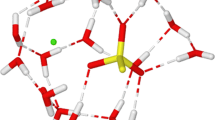Abstract
Analysis of literature indicates that the strength of superacids is mainly determined by unusual chemical properties of weakly solvated protons while the extent of dissociation of superacids is rather low and is less important. A higher chemical activity of protons in very concentrated acids and in such water-free superacids as liquid HF or 100% H2SO4 results from a weaker solvation of these species with the molecules of superacids which are less basic than water. In contrast, solvation by superacids of the negatively charged anions is stronger than in water solutions. These conclusions are illustrated by the ab initio quantum chemical calculations performed for self-dissociation of anhydrous liquid hydrofluoric acid.
Similar content being viewed by others
References
J.N. Brønsted and K.J. Pederson, Z. Phys. Chem. 108 (1924) 185.
J.N. Brønsted, Trans. Faraday Soc. 23 (1927) 416.
J.N. Brønsted, Trans. Faraday Soc. 24 (1928) 630.
J.N. Brønsted, Chem. Rev. 5 (1928) 231.
R.P. Bell, The Proton in Chemistry (Chapman and Hall, London 1973).
F.A. Cotton and G. Wilkinson, Advanced Inorganic Chemistry (Wiley, New York, 1988).
B.I. Nekrasov, Basics of General Chemistry (Nauka, Moscow, 1969) (Russ.).
A. Volmer, Annalen 440 (1924) 200.
G. Zundel, Z. Phys. Chem. NF 58 (1968) 225.
N.B. Librovich, V.D. Mayorov and V.A. Saveliev, Proc. Russ. Acad. Sci. 225 (1975) 1369, (in Russian).
S. Scheiner, Acc. Chem. Res. 18 (1985) 174.
E. Wicke, E. Eigen and Th. Ackermann, Z. Phys. Chem. NF 1 (1954) 340.
Y.K. Lau and P. Kebarle, J. Am. Chem. Soc. 104 (1982) 1462.
K. Hiraoka, H. Takimoto and K. Morise, J. Am. Chem. Soc. 108 (1986) 5683.
D. Marx, M.E. Tukerman, J. Hutter and M. Parinello, Nature 397 (1999) 601.
L.P. Hammett, Physical Organic Chemistry (McGraw Hill, New York, 1970).
M.I. Vinnik, Usp. Khim. 35 (1966) 1922, (in Russian).
W.W. Schmidt, K.K. Baldridge, J.A. Boatz, S.T. Elbert, M.C. Gordon, J.H. Jensen, S. Koseki, N. Matsunaga, K.A. Nguyen, S.J. Su, T.L. Windus and T.A. Montgomery, J. Comput. Chem. 14 (1996) 1347.
S. Miertus, E. Scrocco and J. Tomasi, Chem. Phys. 55 (1981) 117.
G.C. Pimentel and A. McClellan, The Hydrogen Bond, ed. L. Pauling (San Francisco, 1960).
G.A. Olah, G.K.S. Prakash and J. Sommer, Superacids (Wiley, Chichester, 1985).
V.B. Kazansky, Kinet. Katal. 37 (1996) 672, (in Russian).
V.B. Kazansky, Appl. Catal. A 188 (1999) 121.
Author information
Authors and Affiliations
Rights and permissions
About this article
Cite this article
Kazansky, V. Solvation of protons and the strength of superacids. Topics in Catalysis 11, 55–60 (2000). https://doi.org/10.1023/A:1027264317915
Issue Date:
DOI: https://doi.org/10.1023/A:1027264317915




